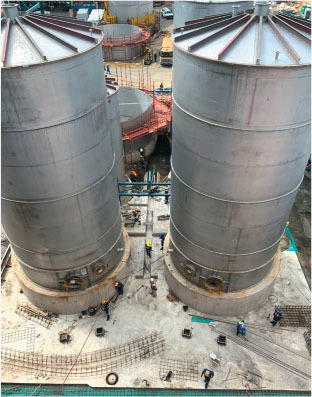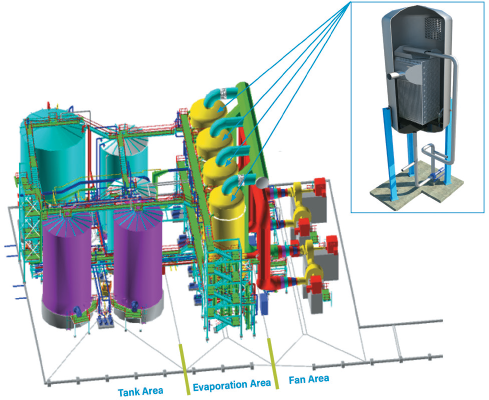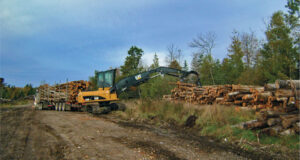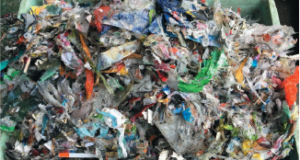
Sappi Saiccor is the world’s largest pulp producer for the viscose fiber industry based on the sulfite process. The Saiccor mill is located 50 km south of the port of Durban in the South African province of KwaZulu-Natal; it produces dissolving pulp (DP) for Sappi Ltd., the world’s leading provider of solutions for paper, paper pulp, dissolving pulp, and biorefineries. Sappi Saiccor’s chemical pulp is produced using a unique cellulose chemistry technology from sustainably grown eucalyptus. In terms of a circular economy, sustainable production processes are maintained by production facilities, many of which are operated with bioenergy from steam and waste streams.
An important objective of what is called the “Vulindlela Project” was to increase the capacity of the Saiccor mill from 783,000 tpy to 890,000 tpy. At the same time, production costs and the mill’s environmental footprint were to be reduced by decreasing its reliance on fossil fuels.
In its entirety, the project included the installation of a new evaporator recovery boiler, a screening and washing plant, upgrades to the bleach plant and pulp machines, improved recovery circuits, and additional magnesium digesters.
GIG Karasek supplied the evaporation plant with mechanical vapor recompression for the concentration of the sulfite liquor. The innovative process solution has a positive effect on the cycle due to high-energy efficiency and low emissions, which saves valuable resources.
According to Wayne Weston, director of projects at Sappi Saiccor, the company chose GIG Karasek due in part to good performance at other Sappi mills in Europe. “GIG Karasek has a good understanding of the unique challenges faced in sulphite evaporators. They were willing to listen to problems faced at Saiccor and amend their designs to overcome these problems by implementing cost effective solutions,” says Weston. “The project execution and cooperation on site was also very good. GIG Karasek’s response to problems and issues was immediate and effective.”

EVAPORATION PLANT IN THE PULP PRODUCTION CYCLE
To produce wood-free pulp, the fibers must be separated from the wood. The wood chips are first broken down in a complex cooking process using suitable chemicals, which breaks the bond between the pulp fibers and lignin.
The pulp is separated from the unbroken wood particles and washed in the liquor from the fiber line. In this procedure, the fibers are separated from lignin and resins and then processed separately, as follows:
- Fiberline: The cellulose and hemicellulose fibers are cleaned, bleached, dewatered, and dried in further processes.
- Chemical recovery cycle: The chemical recovery (containing lignin and resins) produced during the washing process is too thin for direct combustion and must be evaporated. The sulfite liquor enters the evaporation plant as feed, where it is concentrated and only then fed into the liquor boiler (recovery boiler) as fuel.
The recovery boiler, in turn, generates high-pressure steam, while converting the main chemicals in the used cooking liquor into cooking acid for reuse in the pulping process. This completes the sustainable cycle.
MECHANICAL VAPOR RECOMPRESSORS
At present, multi-stage evaporation plants with live steam as the heating medium are primarily used in the various pulp processes. In the sulfite industry, mechanical vapor recompressors (MVR) are also used for pre-evaporation of black liquor or as evaporation plants in multiple configurations.
Due to the comparatively low increase in boiling point in sulfite waste liquors, it is possible to implement the entire evaporation process up to the final concentration using this technology. As a result, it is possible to design evaporation processes that operate almost entirely without live steam supply and cooling water. Only electrical energy is required.
This technology is particularly useful at sites with favorable electricity tariffs or limited live steam/cooling water. The process is also highly relevant for the DACH region (Germany, Austria, and Switzerland) because a significant proportion of pulp producers there still use the sulfite process. In addition, a comparatively large number of pulp sites around the world use the sulfite process, where this technology may also be used on a larger scale.

PROJECT MANAGEMENT WITHIN ‘A POSTAGE STAMP’
For GIG Karasek, the Vulindlela project was the first and largest project on the African continent. The project started in May, 2018, and was completed as scheduled in September, 2021, despite the pandemic and other difficulties. The outstanding partnership with the client, the extensive remote work, and a strong construction site team made this possible, in spite of the challenges.
The project cost was more than EUR23 million (more than US$24 million). The evaporation plant was supplied on an EPC-basis — engineering, procurement, and construction of the evaporator plant, including pumps, piping, valves, steel structure, insulation, HSE, and commissioning. The customer provided the wiring and programming. The parts and components were procured globally and delivered from Europe, Asia, and South Africa.
The evaporation plant was built in the heart of the pulp mill, where an old plant had previously been demolished. The available space on the heavily frequented construction site was relatively tight — to use Sappi’s words, “The plant is being built on a postage stamp.” Despite these challenging conditions, the construction site team worked a total of 230,000 hours without any incidents.
The Sappi Saiccor evaporation plant is the largest implemented plant of its kind in the sulfite industry worldwide. With an enormous compressor capacity of 16,000,000 watts, the system evaporates 300 tons of water per hour from the process in order to burn the sulfite liquor in the subsequent combustion boiler. The electrical power output is roughly equivalent to the output of the Graz Mur power station, or 400,000 light bulbs (40W).
GOOD CLEANING PROPERTIES = DURABILITY
As mentioned, a unique feature of this system is that the medium can be concentrated directly from the input concentration to the desired final concentration by mechanical vapor recompression. In addition, the plant is distinguished by excellent cleaning properties, which guarantees durability.
The plant consists of the tank area (thick liquor, thin liquor, condensate tanks); four huge falling film plate evaporators; and the fan area, with four mechanical vapor recompressors. The evaporators each have a height of 14 meters, a diameter of over 6 meters, and a weight of 120 tons. The individual tanks were prefabricated on-site with local suppliers, then mounted by crane on the previously installed foundation. The four plate falling film evaporators were manufactured in Asia under the supervision of GIG Karasek, delivered by ship in South Africa, and then transported to the construction site by special transport.
The process steam (vapor) is raised to a higher temperature level, consequently increasing to a higher energy level with the electrically-driven mechanical vapor recompression system (radial fans). It is then fed back into the process as fresh heating vapor.
ENERGY-EFFICIENT, ENVIRONMENTALLY FRIENDLY
The combination of plate falling film evaporators and mechanical vapor recompression is an effective process solution for the concentration of sulfite liquors. With mechanical vapor recompression, the energy contained in the vapor is not lost but returned to the energy cycle. Consequently, high steam losses can be avoided. In addition, plate falling film evaporators are very easy to clean and provide long service intervals. The implemented system thus operates in a very energy-efficient and environmentally friendly manner.
Concludes Håkan Eriksson, AFRY, area manager-evaporation plant for the Vulindlela project, “GIG Karasek handled the Vulindlela evaporation project in the best, most professional way in all aspects — engineering, implementation, quality of equipment, erection, safety, and commissioning — with knowledgeable and dedicated personnel that were always very cooperative.”
 Paper 360
Paper 360


